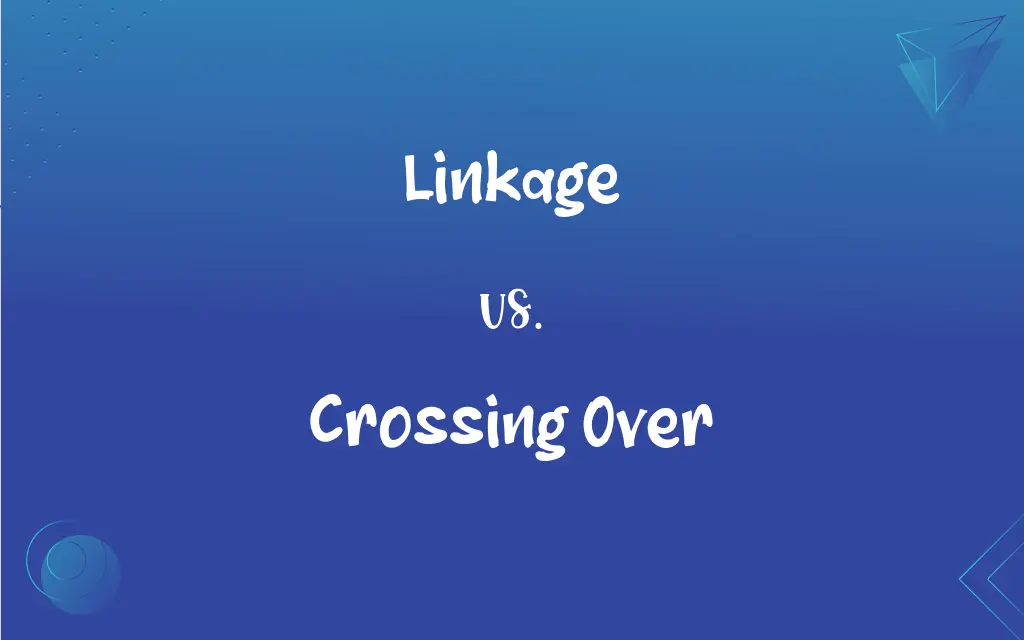Linkage vs. Crossing Over: What's the Difference?
Edited by Aimie Carlson || By Harlon Moss || Updated on October 28, 2023
Linkage refers to the tendency of genes on the same chromosome to be inherited together; crossing over is the exchange of genetic material between homologous chromosomes.

Key Differences
Linkage occurs when genes are located close together on the same chromosome, leading to their inheritance as a group. In contrast, crossing over involves the physical exchange of chromosome segments between homologous chromosomes, creating genetic diversity.
The concept of linkage limits the genetic variation that can arise from sexual reproduction, as linked genes tend to be passed down together. Conversely, crossing over disrupts linkage by recombining genes, increasing genetic variation among offspring.
In linkage, the probability of genes being inherited together depends on their proximity on the chromosome. In the case of crossing over, the frequency is influenced by the distance between genes; farther apart genes are more likely to be separated by crossing over.
Linkage can be detected through breeding experiments or genetic mapping, revealing clusters of genes that exhibit co-inheritance. Crossing over, on the other hand, can be observed through genetic recombination events, which break the patterns of linkage.
While linkage restricts the number of possible genetic combinations, crossing over is a fundamental mechanism that contributes to genetic diversity, essential for evolution and adaptation.
ADVERTISEMENT
Comparison Chart
Basic Definition
The inheritance of genes together due to proximity on a chromosome.
Exchange of genetic segments between homologous chromosomes.
Role in Genetic Variation
Limits genetic variation due to co-inheritance of genes.
Increases genetic variation through recombination.
Frequency Determinants
Proximity of genes on the chromosome.
Distance between genes; further apart increases likelihood.
Observational Methods
Detected through breeding experiments and genetic mapping.
Observed via genetic recombination events.
Evolutionary Impact
Restricts genetic combinations.
Promotes genetic diversity, essential for evolution and adaptation.
ADVERTISEMENT
Linkage and Crossing Over Definitions
Linkage
In genetics, linkage is the tendency of certain genes to be inherited together.
Genetic studies often examine linkage to understand hereditary diseases.
Crossing Over
Literally, it means moving from one side to another.
Crossing over the bridge, she enjoyed the view of the city.
Linkage
In mechanics, linkage is a system of connected parts used to transmit motion.
The linkage in the clock mechanism ensures accurate timekeeping.
Crossing Over
Crossing over is the exchange of genetic material between homologous chromosomes during meiosis.
Crossing over during meiosis increases genetic diversity.
Linkage
Linkage refers to a connection or relationship between two things.
The linkage between diet and health is well established.
Crossing Over
In entertainment, crossing over refers to the appeal or success in different genres or markets.
The singer's latest album achieved crossing over success in both pop and country charts.
Linkage
Linkage can also mean the act of connecting or networking with others.
Professional linkage is crucial for career advancement.
Crossing Over
Crossing over can also denote the blending or exchange of cultural elements.
The artist's work represents a crossing over of various cultural influences.
Linkage
In computing, linkage refers to the process of linking together various software components.
Proper software linkage ensures smooth operation of the application.
Crossing Over
It can refer to the act of moving from one state or condition to another.
The company is in a period of crossing over to a new management style.
Linkage
The act or process of linking.
FAQs
Does linkage occur in all organisms?
Linkage occurs in organisms that reproduce sexually and have chromosomes.
How does crossing over affect genetic diversity?
Crossing over increases genetic diversity by exchanging genetic material between homologous chromosomes.
What is genetic linkage?
Genetic linkage is the tendency of genes located close together on the same chromosome to be inherited together.
Can linkage be broken?
Yes, linkage can be broken by crossing over during meiosis.
Is crossing over a random process?
Yes, crossing over occurs at random points along homologous chromosomes.
What factors influence linkage strength?
The physical distance between genes on a chromosome primarily influences linkage strength.
Does linkage affect all genes on a chromosome?
Not all genes on a chromosome are linked; linkage primarily affects genes that are close together.
What is a linkage map?
A linkage map is a diagram that shows the relative positions of genes on a chromosome based on linkage analysis.
How often does crossing over occur?
The frequency of crossing over varies but typically occurs several times per chromosome pair during meiosis.
Is crossing over essential for life?
Crossing over is essential for producing genetically diverse gametes, contributing to the adaptability of species.
Can crossing over occur between non-homologous chromosomes?
Generally, crossing over occurs between homologous chromosomes, but rare events can involve non-homologous chromosomes.
How is linkage detected?
Linkage is detected through genetic mapping and observing inheritance patterns in breeding experiments.
How does crossing over contribute to Mendelian genetics?
Crossing over explains the genetic variations and deviations from expected Mendelian ratios.
Can crossing over create new genes?
Crossing over does not create new genes, but it can create new combinations of existing genes.
How is linkage used in genetic research?
Linkage is used in genetic research to map genes and understand inherited diseases.
Are linkage and crossing over mutually exclusive?
No, while linkage refers to the co-inheritance of genes, crossing over can disrupt this by recombining genes.
Can crossing over result in genetic disorders?
Improper crossing over can lead to genetic disorders due to the unequal exchange of genetic material.
Can environmental factors influence linkage?
Environmental factors don't directly influence linkage, which is a genetic phenomenon.
Does crossing over occur in asexual reproduction?
Crossing over typically occurs during sexual reproduction and is not a feature of asexual reproduction.
What role does crossing over play in evolution?
Crossing over plays a crucial role in evolution by generating genetic diversity, which is the raw material for natural selection.
About Author
Written by
Harlon MossHarlon is a seasoned quality moderator and accomplished content writer for Difference Wiki. An alumnus of the prestigious University of California, he earned his degree in Computer Science. Leveraging his academic background, Harlon brings a meticulous and informed perspective to his work, ensuring content accuracy and excellence.
Edited by
Aimie CarlsonAimie Carlson, holding a master's degree in English literature, is a fervent English language enthusiast. She lends her writing talents to Difference Wiki, a prominent website that specializes in comparisons, offering readers insightful analyses that both captivate and inform.
































































